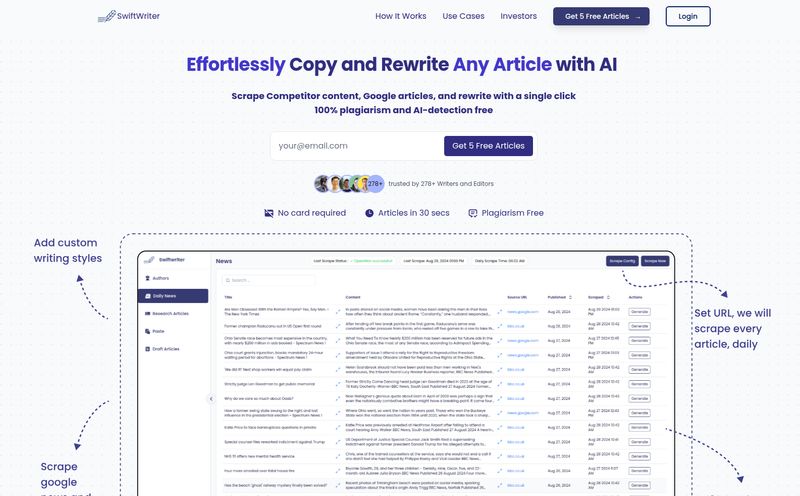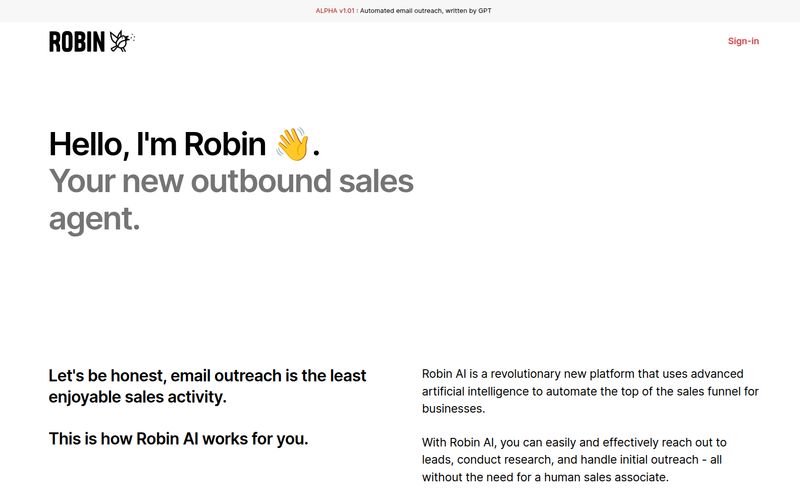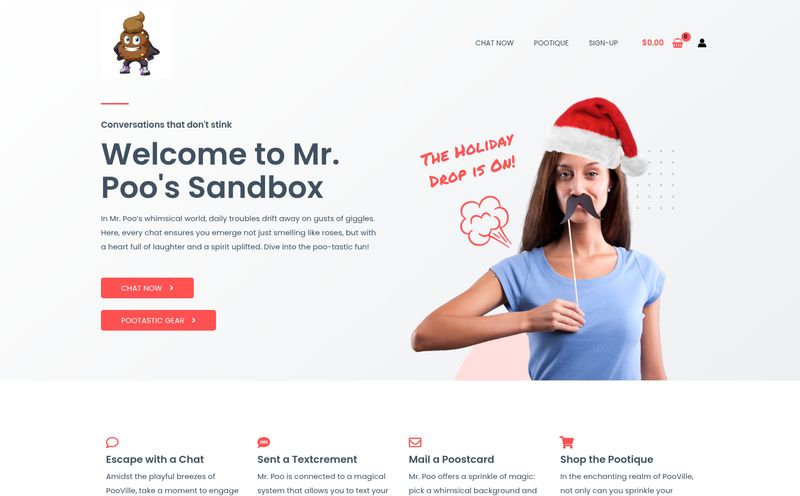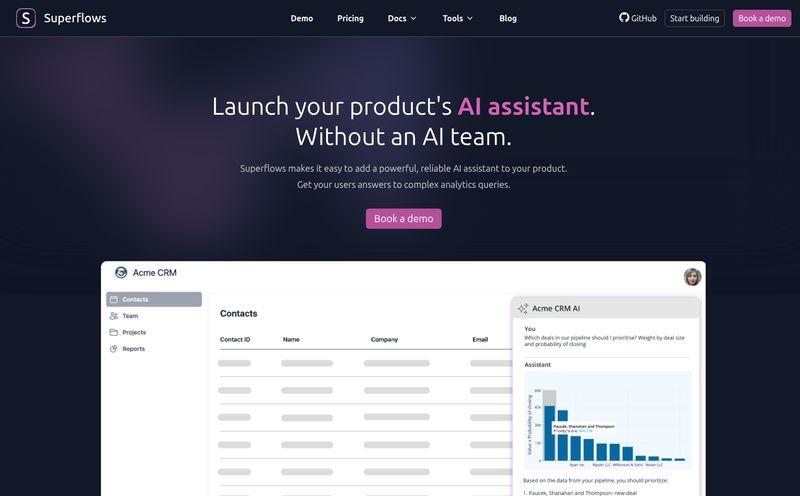The AI hype train is moving at a million miles an hour, and most of us are just standing on the platform wondering which ticket to buy. Every day there's a new 'game-changing' tool that promises to revolutionize your business. As someone who's been in the SEO and traffic game for years, I've seen these waves come and go. Most of them are just noise. A flash in the pan.
But every now and then, something comes along that genuinely makes you lean in. Something that feels less like a far-off promise and more like a practical tool you can use right now. For me, that's the feeling I'm getting from the no-code AI space, and specifically, from a platform I've been tinkering with called FlowHunt.
The big promise? Build your own AI tools, chatbots, and automated workflows without having to write a single line of code. It sounds good, sure. But does it actually work? Let's get into it.
So, What Exactly is FlowHunt? (Beyond the Hype)
Think of it like this: if building a custom AI solution from scratch is like being a master chef who sources every single raw ingredient, grinds their own spices, and painstakingly crafts a meal... FlowHunt is like getting one of those high-end meal kits. All the premium, pre-prepped ingredients (the AI models and functions) are there. You just have to follow the visual recipe card and put them together in a way that makes sense for you. It's still your creation, but you get to skip all teh tedious, complicated prep work.
At its heart, FlowHunt is a visual, no-code platform. You get a blank canvas and a library of 'blocks'—each block being a specific AI function, a data source, or a logical step. You drag, you drop, you connect the dots. The goal is to create everything from a simple AI-powered chatbot for your website to a complex internal tool that automates a chunk of your team's repetitive tasks.
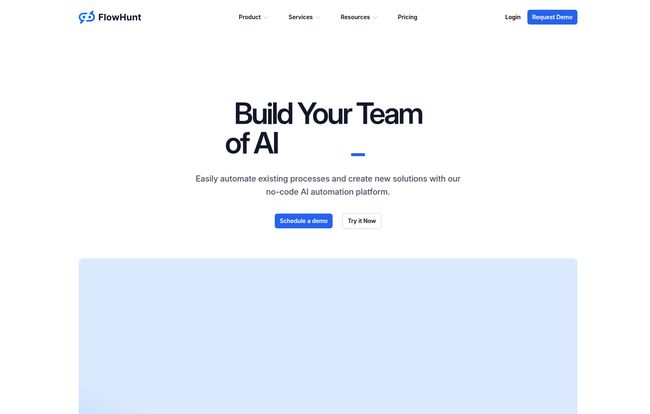
Visit FlowHunt
Putting FlowHunt's Core Features Under the Microscope
Okay, let's pop the hood. A tool is only as good as what it can actually do. From what I've seen, FlowHunt hangs its hat on a few key pillars.
The Visual, No-Code Builder
This is the main event. The interface is clean and, dare I say, intuitive. If you've ever used a tool like Zapier, Make, or even a mind-mapping software, you'll feel right at home. You're literally building a flowchart of how you want your AI to think and act. For example, a block for 'User Input' connects to a 'GPT-4 Analysis' block, which then connects to a 'Display Answer' block. It’s a very tangible way to build something that can feel incredibly abstract.
More Than Just Chatbots: AI Agents and Workflows
This is where my interest really piqued. Building a chatbot that answers questions from a knowledge base is cool, and FlowHunt does that well. But building an AI agent is a different beast. We're talking about setting up a workflow that doesn't just answer questions but actively does things. Imagine an agent that monitors new customer sign-ups, researches their company online, and then drafts a personalized welcome email. That's the kind of automation that saves real, measurable time. This moves beyond simple Q&A and into genuine workflow automation.
The AI Tools Library: Your Pre-Built Arsenal
This might be the most valuable part of the platform. FlowHunt boasts a library of over 100 AI tools for different use cases. This means you aren't starting from zero. You can grab a pre-built template for 'Sentiment Analysis' or 'Content Summarization' and drop it right into your workflow. It saves you from having to figure out the complex prompting and logic for common AI tasks. For a marketer like me, this is gold. I can quickly spin up tools for ad copy generation or SEO keyword clustering without needing to call in a developer.
Who Is This Actually For? Real-World Use Cases
A tool that claims to be for 'everyone' is usually for no one. But FlowHunt does a decent job of outlining who can get the most out of it. I can see it being a huge help for a few key groups:
- Marketing Teams: Oh, the possibilities. Build a tool to analyze competitor websites, generate blog post ideas based on trending topics, or create an interactive lead magnet that qualifies visitors on your site. The speed at which you can test new ideas is a massive advantage.
- Sales Leaders: Automate lead research, create a chatbot that books demos 24/7, or build an internal tool that drafts follow-up emails. Anything that frees up a salesperson's time to actually sell is a win.
- HR & Recruitment: Imagine an AI assistant that can do the first pass on resumes, shortlisting candidates based on key criteria. Or a chatbot that answers common questions from new hires during their onboarding. It's about offloading the high-volume, low-complexity work.
- Solopreneurs and Small Businesses: This is a big one. When you don't have a dedicated tech team, being able to build your own custom tools is a superpower. It lets you punch way above your weight class.
Let's Talk Money: The FlowHunt Pricing Tiers
Alright, the all-important question: what's this going to cost me? FlowHunt uses a credit-based system, which is pretty common in the AI space. Essentially, you pay for a certain number of credits per month, and different actions consume those credits.
| Plan | Price | Details |
|---|---|---|
| Starter | €10 /month | 10 Credits (up to 1,000 interactions). Perfect for individuals just experimenting. |
| Pro | €50 /month | 50 Credits (up to 5,000 interactions). The sweet spot for small teams and businesses. |
| Premium | €500 /month | 500 Credits (up to 50,000 interactions). For companies running complex AI at scale. |
| Enterprise | From €1500 /month | Custom tokens, unlimited interactions, white-label options. The big league. |
My take? The credit system is a double-edged sword. It's great because it means you're only paying for what you use, and the Starter plan is incredibly accessible for just trying things out. However, you have to monitor your usage. If you build a popular chatbot, those interactions can add up fast. For most serious small businesses, the Pro plan feels like the right balance of cost and capability.
The Unvarnished Truth: Pros and Cons
Look, no tool is perfect, and I'm not here to sell you a dream. After playing around with FlowHunt, here's my honest breakdown.
The biggest pro is the sheer accessibility. The barrier to entry for creating custom AI tools has historically been a PhD in computer science. This genuinely lowers that barrier to almost nothing. The speed at which you can go from an idea to a working prototype is fantastic for agile teams.
On the flip side, the reliance on pre-built blocks means there's a ceiling on customization. Some might argue that this isn't for true 'power users' and they're not entirely wrong. If you want to fine-tune a model on a granular level or build something wildly unconventional, you'll probably still need to code it from scratch. But for 95% of practical business applications? This is more than enough. I also think the credit-based pricing, while fair, can cause some anxiety for users who are worried about unexpected costs if a tool suddenly goes viral.
My Final Verdict: Should You Give FlowHunt a Shot?
So, is it worth it? In my opinion, yes. Absolutely. If you're a marketer, a business owner, or just a curious tinkerer who has ideas for how AI could help your work but you don't have the coding skills to back it up, FlowHunt is a fantastic starting point. It's a powerful enabler.
It’s not going to replace your development team for highly complex, mission-critical software. But what it will do is empower you and your team to solve your own problems, to automate the boring stuff, and to experiment with AI in a way that was impossible even a couple of years ago. It’s a tool that fosters creativity and efficiency, and in my book, that's a winning combination.
Frequently Asked Questions about FlowHunt
- Is FlowHunt good for complete beginners?
- Yes, that's its core strength. The visual builder and template library are designed specifically for people without a technical background. If you can make a flowchart, you can use FlowHunt.
- How exactly do the credits work?
- Think of credits as your monthly allowance for AI processing. Each interaction with your AI tool or chatbot, like a user asking a question or a workflow running, consumes a small fraction of a credit. The credits reset each month, and they don't roll over.
- What happens if I run out of credits during the month?
- Your AI tools will temporarily stop working until your credits reset at the start of the next billing cycle. You also have the option to upgrade your plan mid-month to get more credits immediately.
- Can I integrate FlowHunt with other software I use, like Slack or my CRM?
- Yes, the platform is built with integration in mind. You can connect FlowHunt to many popular platforms to send data back and forth, making your automated workflows even more powerful.
- Can I get a demo before signing up?
- According to their site, yes. They offer demos where their team can walk you through the platform and answer specific questions about your use case, which is a great touch.
Conclusion
We're moving out of the era where AI was something only huge tech companies could afford to play with. Tools like FlowHunt are democratizing access to powerful technology, putting it in the hands of the people who are actually on the front lines of business. It's about empowerment. It's not about replacing humans, but about giving us smarter tools to work with. If you've been sitting on the sidelines of the AI revolution, a platform like this might just be the ticket you've been waiting for.
